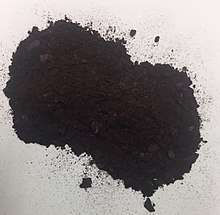Methylidynetricobaltnonacarbonyl
9.png) | |
 | |
| Names | |
|---|---|
| Other names
methylidyne-tris(tricarbonylcobalt) | |
| Identifiers | |
| Properties | |
| C10HCo3O9 | |
| Molar mass | 441.91 g·mol−1 |
| Appearance | purple solid |
| Density | 2.01 g/cm3 |
| Melting point | 105–107 °C (221–225 °F; 378–380 K) |
Except where otherwise noted, data are given for materials in their standard state (at 25 °C [77 °F], 100 kPa). | |
| Infobox references | |
Methylidynetricobaltnonacarbonyl is the organocobalt compound with the formula HCCo3(CO)9. It is a metal carbonyl cluster that contains the methylidyne ligand. The compound has C3v point group symmetry. It is a purple, air-stable solid that is soluble in some organic solvents, but not in water.
The compound is prepared by the reaction of dicobalt octacarbonyl with bromoform. Much of the cobalt(0) is consumed in the formation of cobalt(II) bromide. An idealized equation for the synthesis is:[1]
- 9 Co2(CO)8 + 4 CHBr3 → 4 HCCo3(CO)9 + 36 CO + 6 CoBr2
Many analogues are known such as the benzylidyne, arsinidyne, and chloromethylidyne derivatives, respectively BnCCo3(CO)9, AsCo3(CO)9 and ClCCo3(CO)9.
The structure has been analyzed by X-ray crystallography. The Co-Co distances are near 2.48 Å in length. The compound is structurally related to tetracobalt dodecacarbonyl.[2]
References
- ↑ Mara O. Nestle, John E. Hallgren, Dietmar Seyferth (1980). "μ3-Methylidyne and μ3-Benzylidyne-Tris(Tricarbonylcobalt)". Inorg. Synth. 20: 226–229. doi:10.1002/9780470132517.ch53.
- ↑ P. Leung, P. Coppens, R. K. McMullan, T. F. Koetzle (1981). "The Structure of Nonacarbonyl-[mu]3-methylidyne-triangulo-tricobalt. X-ray and Neutron Diffraction Studies". Acta Crystallogr. B. 37: 1347–1352. doi:10.1107/S0567740881005906.